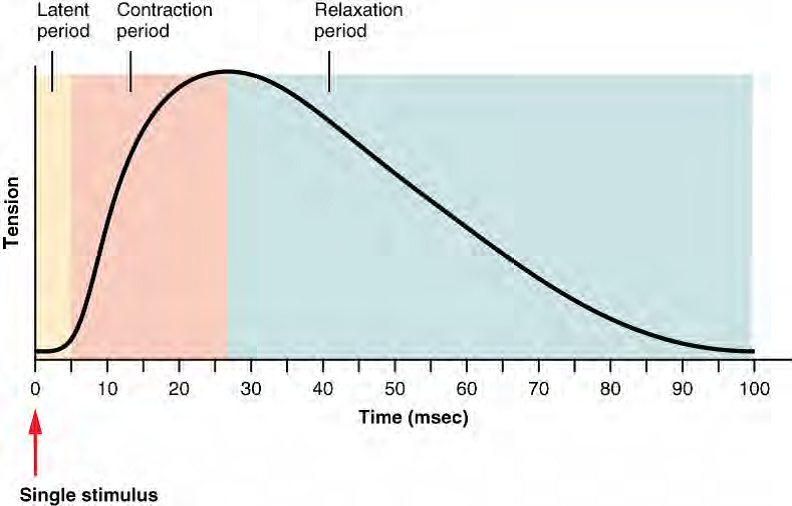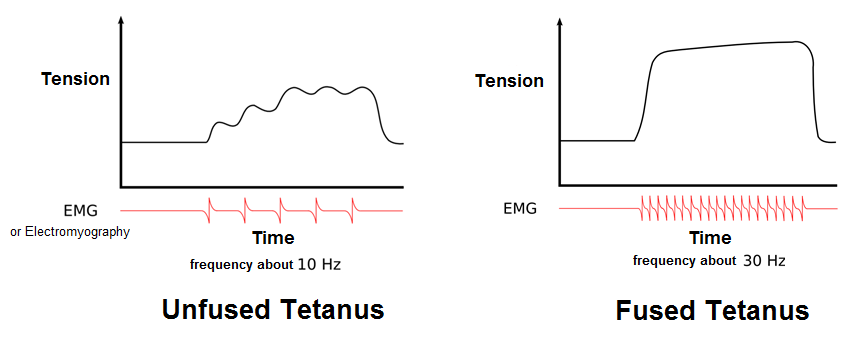Muscle Twitch and Summation (Myograms)
A single action potential from a somatic motor neuron will produce a single contraction in the muscle fibers of its motor unit. As we have stated before, this isolated singular contraction/relaxation cycle is called a twitch. A twitch can last for a few milliseconds or 100 milliseconds, depending on the muscle type. The tension produced by a single twitch can be measured by a myogram, an instrument that measures the amount of tension produced over time. Each twitch undergoes three phases. The first phase is the latent period, during which the action potential is being transmitted along the sarcolemma and Ca2+ ions are released from the SR (Steps # 7 - 11). This is the phase during which excitation and contraction are being coupled but contraction has yet to occur. The contraction phase occurs next. The Ca2+ ions in the sarcoplasm have bound to troponin, tropomyosin has shifted away from myosin-binding sites, cross-bridges formed, and sarcomeres are actively shortening to the point of peak tension (Steps # 12 - 14). The last phase is the relaxation phase, when tension decreases as contraction stops. Ca2+ ions are actively pumped out of the sarcoplasm into the sarcoplasmic reticulum, and cross-bridge cycling stops, returning the muscle fibers to their resting state.

Figure 1: This Myogram of a Muscle Twitch shows a graph of an increasing line to a peak during the contraction period then a slower decline afterwards in the Relaxation period. A single muscle twitch has a latent period, a contraction phase when tension increases, and a relaxation phase when tension decreases. During the latent period (short flat line at the beginning of the graph), the action potential is being spread along the sarcolemma. During the contraction phase (a rapid increase in the slope of the graph), Ca++ ions in the sarcoplasm cause the steps of contraction to occur. During the relaxation phase, tension decreases (the slope on the graph goes down) as Ca++ ions are pumped out of the sarcoplasm and cross-bridges detach as contraction stops.
Although a person can experience a muscle "twitch," a single twitch does not producesignificant muscle tension in a living body. Meaning that if I wanted to lift my coffee mug, there is not enough tension produced by single muscle twitch to support this motion. A series of action potentials to the muscle fibers is necessary to produce a muscle contraction that can produce work such as lifting the mug. Normal muscle contraction is more sustained, and it can be modified by input from the nervous system to produce varying amounts of force; this is called a graded muscle response. The frequency of action potentials from a somatic motor neuron and the number of somatic motor neurons transmitting action potentials both affect the tension produced in skeletal muscle.
The rate at which a motor neuron fires action potentials affects the tension produced in the skeletal muscle. If the fibers are stimulated while a previous twitch is still occurring, the second twitch will be stronger. This response is called wave summation, because the excitation-contraction coupling effects of successive motor neuron signaling is summed, or added together. At the molecular level, summation occurs because the second stimulus triggers the release of more Ca2+ ions, which become available to activate additional sarcomeres while the muscle is still contracting from the first stimulus. Summation results in greater contraction of the motor unit. More simply - think back to your Steps # 1-14: the more action potentials that travel down the somatic motor neuron, the more ACh released into the synaptic cleft => the more action potentials that travel down the sarcolemma => the more calcium released from the sarcoplasmic reticulum = > more contraction => more force production due to wave summation.

Figure 2. Wave Summation Myogram. The excitation-contraction coupling effects of successive motor neuron signaling is added together which is referred to as wave summation. The bottom of each wave, the end of the relaxation phase, represents the point of stimulus and will start a new signal before the first one completely relaxed.
If the frequency of somatic motor neuron signaling increases, summation and subsequent muscle tension in the motor unit continues to rise until it reaches a peak point. The tension at this point is about three to four times greater than the tension of a single twitch, a state referred to as incomplete or unfused tetanus. During incomplete tetanus, the muscle goes through quick cycles of contraction with a short relaxation phase for each. Notice that force production increases but then declines slightly before beginning to increase again. This decline in force production is the partial relaxation between contractions and lends a sawtooth appearance to incomplete tetanus on the myogram. If the stimulus frequency is so high that the relaxation phase disappears completely, contractions become continuous in a process called complete tetanus. During tetanus, the concentration of Ca2+ ions in the sarcoplasm allows virtually all of the sarcomeres to form cross-bridges and shorten, so that a contraction can continue uninterrupted (until the muscle fatigues and can no longer produce tension). A myogram of complete tetanus shows a steep rise in tension production that plateaus when the muscle is contracting fully, and then a decline in force production that is caused when the muscle begins to fatigue from the continuous contraction.

Figure 3. Myograms for Unfused Tetanus versus Fused Tetanus. During incomplete tetanus, the muscle goes through quick cycles of contraction with a short (incomplete) relaxation phase for each. If the stimulus frequency is so high that there is no relaxation phase (it disappears completely), contractions become continuous in a process called complete tetanus.